
reduction strategies for commercial and industrial customers ENERGY SOLUTIONS FOR COMMERCIAL & INDUSTRIAL CUSTOMERS energysolutionscenter.org
Carbon
TABLE OF CONTENTS
12 Adopting CHP
CHP adds resiliency, lowers costs and reduces carbon footprint.
16 Made in America
Start-up PPE manufacturer reduces vulnerability for supply chain disruptions using natural gas.
17 How low can you go?
Start with natural gas: Five carbon reduction strategies for commercial and industrial customers.
10 Decarbonizing natural gas
Reducing carbon concentration in natural gas and blending hydrogen with natural gas lowers carbon emissions while allowing users to maintain existing equipment and processes.
13 What’s brewing?
Ultra-high efficiency roaster brews up coffee producer’s sustainability solution.
14 Chilling with natural gas
Connecticut school district earns tax credits while saving energy and protecting the environment.
16 Boosting energy efficiency
Energy analyses and software systems identify energy inefficiencies and highlight opportunities for saving.
GasTechnology is a product of Energy Solutions Center, and is published in cooperation with PRISM Media Group. We offer our special thanks to the utilities and other businesses that sponsored this issue.
Adopting CHP
CHP adds resiliency, lowers costs and reduces carbon footprint.
 By Drew Robb
By Drew Robb
President Ray Larson
Editorial Director Stephanie Anderson Forest
Graphic Designer Nancy Kekich
Contributing Writers Tonya McMurray, Drew Robb, Monica Stavish Skaggs
GasTechnology is published by PRISM Media Group, 8951 Cypress Waters Blvd., Ste. 160, Coppell, TX 75019. Visit prismmediagroup.com. No part of this publication may be reprinted without permission. © 2023 Energy Solutions Center
While in the early stages, there is a lot of discussion about the gradual transition to renewable sources of energy, as the bulk of North America continues to use traditionally produced electricity. The electric grid is transitioning away from coal and replacing that with natural gas and renewable power sources. But in the quest for higher efficiency, commercial and industrial facilities are installing combined heat and power (CHP) systems.
Almost all new CHP facilities opt for natural gas as their primary fuel. Why? Natural gas adds resiliency to any facility, lowers fuel and operating costs and helps to lower the carbon footprint.
New hospital adopts Chp
Take the case of the recently built Allegheny Health Network (AHN) Wexford Hospital in Pine Township near Pittsburgh, Pennsylvania. It offers convenient access to a wide range of clin-
ical services. These include labor and delivery; advanced cardiac, neurosurgical, orthopedic and cancer care; a 24-room emergency department and short-stay observation unit; an adult intensive care unit; operating rooms that provide minimally invasive robotic surgical capabilities; 160 all-private inpatient rooms; and a host of other clinical programs, amenities and services.
“The CHP facility powers, cools, heats and provides emergency services to the hospital,” said Jeffrey Nehr, vice president of business development at Peoples Natural Gas Co. (PNG).
The combined heat, cooling and power system within the 18,000-square-foot, two-story power plant facility at AHN Wexford Hospital simultaneously produces up to two megawatts of electricity and thermal energy on-site to meet all energy needs, including electricity, heat, chilled water, hot water and steam. A large team
2 energysolutionscenter.org
P H o T o C ou RTES y o F P E o PLES N AT u RAL G AS Co.
An Innio Jenbacher natural gas engine provides the AHN Wexford Hospital with 2 megawatts of power and features to enhance heat recovery, assure stable combustion, reduce emissions and increase efficiency.
of organizations collaborated to bring this project to fruition. As well as PNG, companies such as LLI Engineering, PJ Dick Construction and North-East Western Energy Systems (NES-WES) worked closely with AHN Wexford Hospital on the design and construction of the facility.
The CHP system offers several benefits compared to conventional electrical and thermal energy production. On-site generation is more efficient. It eliminates wasted energy during typical transmission and distribution, while reducing emissions of greenhouse gases (GHGs) and air pollutants. The system provides a redundant source of power to the hospital, supporting continuous operations and maximizing patient safety.

“Natural gas CHP provides extremely reliable power and heating — or cooling — to a building 24x7x365 at an efficiency level that is much higher and with emissions that are lower than the grid,” said Aaron Tasin, vice president of sales and engineering at NES-WES.
“Since the power is generated directly on-site, there is almost no weather pattern or grid issue that disturbs the building from being able to run independently of the grid. It does not matter if it is a hurricane or an ice storm, the building will always be able to operate.”
He said the gas engine provided to AHN Wexford Hospital is an Innio Jenbacher JMS612 machine. As well as providing 2 megawatts of power, this Jenbacher Type 6 unit includes features to enhance heat recovery, assure stable combustion, reduce emissions and increase efficiency. A centrally located purged pre-combustion chamber helps provide optimal ignition conditions. The spark plug ignition energy is amplified in the pre-combustion chamber, facilitating stable and reliable combustion.
“These gas engines maintain full output during high temperatures and altitudes, so they’re not subject to degradation during high temperatures, and they have low fuel consumption which means a lower heat rate and low-cost
energy,” said PNG’s Nehr.
The large amount of waste heat produced at typical power plants is just that — wasted heat. This new hospital, on the other hand, harnesses CHP system to be able to operate at efficiencies as high as 90%. Through an exhaust gas heat exchanger, it generates enough hot and chilled water and steam to meet all the needs of the hospital. It can produce more electricity than can be consumed on-site. As a result, any unused energy provides another revenue stream as it can be sold back to the grid.
For more information, visit:
North-East Western Energy Systems: nes-wes.com
Innio Jenbacher: innio.com/en
3
Chp: a game-changer
Capstone’s microturbines deliver low-cost energy resiliency by increasing the reliability of supply.
By Drew Robb
ACanadian high-rise condominium complex in Scarborough, Ontario, struggled with electricity and gas bills that accounted for nearly 60% of operating expenses. Faced with rising expenses and an additional budget pinch that included a 28% increase in facility maintenance fees, the complex’s owners needed to take urgent steps to bring down costs.
Energy consumption reduction measures included suite metering and automation, switching to LED lighting in common areas and implementing more energy-efficiency equipment. But the biggest gains came via the installation of an on-site combined heat and power (CHP) system to replace utility-provided electricity. This not only lowered energy costs, but it also improved resiliency by increasing the reliability of supply.
Two C65 microturbines from Capstone Green Energy Corp. sit at the heart of the CHP system. As well as electricity, the waste heat from the microturbine exhaust is fed to a 100-ton absorption chiller to improve the efficiency of building heating and cooling systems.
“CHP has been a game-changer in our drive to control energy costs,” said Zahir Antia, secretary of the condominium owners’ association. “We are very satisfied with our decision to choose Capstone microturbines, as we have minimal maintenance requirements and no complaints of noise or vibration from our residents.”
Phased installation
The CHP system evolved over several phases. The original equipment replaced an old boiler with one Capstone C65 CHP microturbine unit. It generated electricity for over half of the electricity needs of the common areas. During the generation process, the waste heat provided the building and its residents with both hot water year-round and heat during the cold months of the year.
Building on the success of the CHP system, the owners recognized the potential for even greater energy savings and efficiency. That led to a more ambitious trigeneration system. They added a second Capstone C65 CHP unit and followed that with a 100-ton direct exhaust absorption
Earlier this year, Capstone Green Energy Corp.’s C65 microturbine was recertified by the California Air Resources Board (CARB) as a distributed generation resource exempt from CARB’s emission standards. The C65 was first certified in 2007 and has maintained its CARB certification and compliance with the board’s testing standards for the last 15 years.
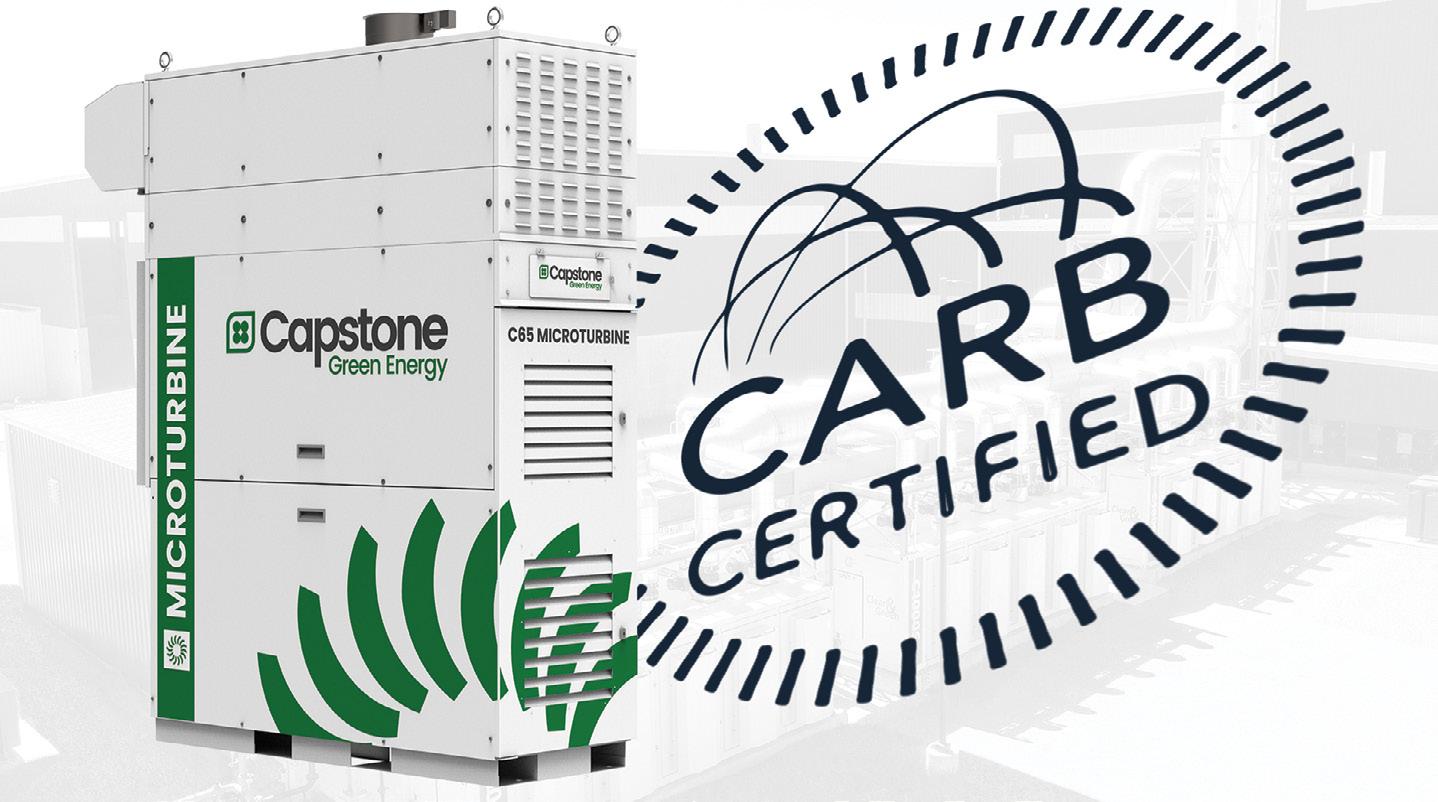
chiller capable of producing 81 tons of refrigeration from the combined exhaust of the two C65 microturbines. The result is a combined cooling, heat and power solution that provides nearly all of the electricity for the common areas and is able to utilize all heat produced year-round. By eliminating an old, inefficient electric chiller and replacing it with a natural gas-based absorption chiller, energy costs were further reduced.
Due to a compact design, the installation fits into the existing penthouse boiler room without the need for changes to the mechanical equipment layout or other structural modifications.
Results
The reduction in energy costs for the complex has been dramatic. The facility saves approximately $90,000 per year from the nearly 75% average CHP system efficiency. The two Capstone C65 CHP microturbines fueled by natural gas provide the condo complex with reliable power, delivering 99% uptime with only 1% downtime only, due to scheduled maintenance requirements. Combined,
the two C65 systems have operated problem-free for more than 40,000 hours and have generated more than 2,200 megawatt hours during that time.
As energy costs continue to rise in the region, the annual electricity and gas budget for the building has decreased to $210,000, less than half of its previous amount. As a result, energy costs fell to 21% of the complex’s overall operating expenses. Combined with $250,000 in government incentives, the ongoing savings have yielded an attractive return on investment.
According to the owners, grid electricity usage dropped by 94%. As well as greatly lowered costs, those reductions translate into a lower carbon footprint and reduced emissions, which is important to both owners and tenants.
For more information, visit: Capstone Green Energy Corp.: capstonegreenenergy.com
4 energysolutionscenter.org
P H o T o C ou RTES y o F C APST o NE G REEN E NERG y Co RP
There’s Never Been a Better Time to GO GREEN


Are you ready to unlock incredible savings while boosting reliability and energy efficiency? No matter your industry – healthcare, education, hospitality, or manufacturing – Capstone Green Energy has the perfect solution tailored to your needs and budget.


Take advantage of the new Energy Investment Tax Credit (ITC) and enjoy a minimum 30% tax credit for microturbine combined heat and power (CHP) projects installed by 2024. Now is the time to embrace sustainability, build resiliency, enhance reliability, and reduce costs. The power is in your hands!



1.818.734.5300 | www.capstonegreenenergy.com Learn More!
Learn How You Can Save Up to 50%
Made in America
Start-up PPE manufacturer reduces vulnerability for supply chain disruptions using natural gas.
By Tonya McMurray
The COVID-19 pandemic exposed many vulnerabilities in the supply chain, including the risk of having many personal protective equipment (PPE) items manufactured outside of the United States.
American Nitrile founder and CEO Jacob Block, who was brokering PPE at the time, recognized a significant need for domestic production of gloves for medical and nonmedical use to reduce the vulnerability of supply chain disruptions.
Most glove manufacturing occurs in the Asia Pacific, primarily Malaysia, with less than 1% made in the U.S., according to IndustryWeek magazine. That led Block to launch American Nitrile. Beginning production at its 527,000-square-foot Grove City, Ohio, facility in 2022, the company expects to produce up to 40,000 gloves per hour, about 3.6 billion each year.
An alternative to latex, nitrile is made from nitrile butadiene rubber, a synthetic substance with an allergy safe compound and a similar feel to latex. Nitrile gloves are up to three times more puncture-resistant than latex and are more cost effective, according to the company.
Fo CusiNg oN sustaiNability
cause of the efficiency and cost,” said Alex Mallison, engineering manager for American Nitrile. “This is the greenest glove facility in the world and that largely has to do with the transfer of energy from the natural gas to the glove.

Natural gas also powers American Nitrile’s large ovens that cure the gloves to their final form, helping the company maintain a low carbon footprint and meet its sustainability goals. The company expects to produce up to 40,000 gloves per hour, about 3.6 billion each year.
The plant uses state-of-the-art technology and is focused on sustainable and efficient manufacturing processes, with a goal of revolutionizing industry sustainability standards. It has a state-of-the-art water reclamation process that recycles 50% of its wastewater and uses natural gas as a water removal and vulcanization tool. The natural gas also powers large ovens that cure the gloves to their final form, helping the company maintain a low carbon footprint and meet its sustainability goals.
“We chose to go with natural gas be-
“Other facilities, both domestic and international, use biomass for heat generation, which means that they have more heat loss through their process, and they are producing many unwanted emissions,” he continued. “The natural gas also allows us to keep a very tight operating window ensuring we are producing gloves of the highest quality.”
While the COVID-19 pandemic was the catalyst for launching the company, the demand for nitrile gloves is expected to continue to grow in health care, hospitality, retail and other sectors.
6 energysolutionscenter.org
For more information, visit: American Nitrile americannitrile.com
We chose to go with natural gas because of the efficiency and cost. This is the greenest glove facility in the world and that largely has to do with the transfer of energy from the natural gas to the glove.
— Alex Mallison, engineering manager, American Nitrile
How low can you go?
Start with natural gas: Five carbon reduction strategies for commercial and industrial customers.
By Drew Robb
A carbon footprint is a way to quantify the volume of emissions released by activities such as electricity generation, driving, farming and manufacturing. It is a measure of carbon intensity (i.e., the amount of carbon dioxide emitted per unit of energy consumed).
When the carbon intensity of fuels such as coal, oil and natural gas are compared, natural gas yields far fewer emissions. No wonder natural gas has now replaced coal as the top fuel used in the U.S. electricity sector.
According to the American Gas Association, natural gas utilities have reduced their greenhouse gas emissions (GHGs) by 69% since 1990.
Here are five strategies that can help commercial and industrial facilities to lower their emissions and minimize their carbon footprint:
1. RespoNsibly souRCed gas
Responsibly sourced gas (RSG) is defined as conventional natural gas certified by a third party that verifies that it meets stringent greenhouse gas emissions standards. Also referred to as certified natural gas, RSG gas must
comply with current regulations related to its collection and delivery so that it produces less than 1% residual methane emissions. C&I facilities and natural gas producers can differentiate themselves in the market by working with third-party verifiers such as MiQ, EO100™ and TrustWell™ to demonstrate their credentials.
2. bleNd hydRogeN with NatuRal gas
Hydrogen does not release GHGs during combustion, hence, there is excitement about its potential use. The two most common methods of producing hydrogen are steam-methane reforming (SMR) and electrolysis. SMR uses high-temperature steam to heat methane from natural gas, producing hydrogen and carbon dioxide. Electrolysis uses an electrical current to split water molecules into oxygen and hydrogen. A way to lower the carbon footprint of natural gas is to introduce small percentages of hydrogen into the natural distribution system.
Some utilities are already blending hydrogen into their natural gas pipelines.
There is a need to develop many more clean hydrogen-generating systems to meet growing demand for hydrogen.
3. iNtRoduCe ReNewable NatuRal gas
Renewable natural gas (RNG) from biomass is another way to lower carbon footprints. This affordable and reliable fuel is compatible with conventional natural gas. RNG is made by capturing and refining biogases released from decomposing organic waste material such as municipal waste, wastewater sludge, animal manure, food waste, biogenic feedstocks, agricultural residues, forest product residues and energy crops. It is considered a carbon-neutral fuel, with even greater benefits when it is produced from organic waste that would otherwise decay and create methane emissions. Since RNG is ready to use in existing natural gas infrastructure, it can be injected into pipelines to immediately reduce the carbon content of natural gas.
4. poweR-to-gas
Power-to-gas (P2G) could become another important component of a
7
low-carbon energy future. P2G converts surplus renewable electricity into hydrogen and can use a bioreactor to convert hydrogen and carbon dioxide captured from another process into a carbon-neutral methane. With minor filtration, the methane meets pipeline quality and can be injected into existing natural gas infrastructure. P2G can improve the economics of zero-carbon fuels and enhance the resilience of the energy supply while increasing the spread of renewable energy.
“Once renewable hydrogen or methane is produced, the gases can be stored indefinitely and utilized in a number of energy sectors including electricity generation, transportation, fertilizer (ammonia) production, and oil and gas,” said Kevin Harrison, senior engineer for power-to-gas at the National Renewable Energy Laboratory (NREL).
5. CaRboN oFFsets aNd CaRboN
CaptuRe aNd sequestRatioN
Further contributors to low carbon energy goals are carbon offsets and carbon capture and sequestration (CCS). Carbon offsets help to fund greenhouse gas reduction projects and serve as credits that balance carbon produced in another location. Each carbon offset purchase represents one metric ton of CO2e reductions. There are also RNG certificates that give the holder ownership of the GHG emissions reduction generated by the cap-
ture of biomethane processed into renewable natural gas.
CCS involves a set of technologies that have been designed to remove carbon from exhaust emissions and store it safely where it causes little to no environmental impact. Some approaches to CCS work upstream of traditional power production processes for coal and natural gas. Their goal is to extract carbon prior to combustion. Alternatively, CCS can be positioned downstream of power production to capture carbon from the exhaust.
Once captured, the carbon is sequestered or stored is a variety of ways. Some use a geological approach while others utilize biological processes. There are also flue gas conversion techniques employed in CCS.
iNNovative gas teChNology
The natural gas industry continues to pursue innovative solutions in its commitment to reduce carbon emissions and provide consumers with sustainable energy choices. By leveraging the above strategies, natural gas can be used to provide affordable energy that helps to lower the global carbon footprint.
For more information, visit:
American Gas Association: aga.org
National Renewable Energy Laboratory: nrel.gov
8 energysolutionscenter.org
Once renewable hydrogen or methane is produced, the gases can be stored indefinitely and utilized in a number of energy sectors including electricity generation, transportation, fertilizer (ammonia) production, and oil and gas.
— Kevin Harrison, senior engineer, power-to-gas, National Renewable Energy Laboratory









Decarbonizing natural gas
By Tonya McMurray
In its efforts to further reduce greenhouse gas emissions, the natural gas industry is marshalling new technologies that offer a more cost-effective way to reduce emissions.
Many commercial and industrial operations rely on natural gas. Switching to electricity or alternative fuels to reduce emissions would require significant reworking of their systems, said Mothusi Pahl, vice president of business development and government affairs at Modern Hydrogen Inc.
“Converting to electricity will cost on the scale of millions of dollars per factory,” he said. “Plus, they would have to shut down their factory to convert and will be subject to power outages, which impacts profits.”
More efficient solutions include removing carbon from natural gas and using hydrogen-enhanced natural gas (HENG) to reduce carbon in the fuel stream. Both technologies create an environmentally
friendly fuel source that works with existing systems and equipment.
pRe-C ombustioN CaRboN CaptuRe
Modern Hydrogen strips carbon from natural gas, preventing those molecules from becoming carbon dioxide. Called “pre-combustion carbon capture,” this technology can be paired with existing gas networks to decarbonize them at stages upstream during gas transmissions, at utility gate stations or directly at an operator’s point of use.
The largest component of natural gas is methane, composed of one carbon atom and four hydrogen atoms. Stripping carbon atoms from natural gas leaves pure hydrogen, which can be used alone or blended back with natural gas for use in heat, steam, power generation and other applications.
“It gets the carbon out of natural gas and the carbon goes into roads to make them more cost-effective to build.”
Modern Hydrogen has entered a strategic partnership with leading industrial boiler manufacturer Miura Co. Ltd. to use its technology to develop new solutions for industrial heating systems. Modern Hydrogen has field trials planned for this year.
Miura produces hydrogen-fueled boilers that emit no carbon dioxide during operation. The partnership between Miura and Modern Hydrogen will combine Miura’s hydrogen technologies with Modern Hydrogen’s decarbonization technique.
heNg demoNstRatioN suCCess
Modern Hydrogen Inc.’s carbon capture technology removes carbon atoms from natural gas, leaving pure hydrogen which can be blended back with natural gas or used alone to fuel a variety of applications.

The process also leaves industrial-grade solid carbon and eliminates the production of carbon dioxide (CO2). The solid carbon can then be sold to asphalt and concrete manufacturers for use in building roads.
“This is a full cycle process,” Pahl said.
A strategic effort between three Buffalo, New York-based companies successfully demonstrated that blending hydrogen with natural gas can create a clean fuel source without disrupting existing operations.
Wheatfield Gardens, an agricultural company which grows high-quality produce and cannabis for local distribution, has a strategic focus on new technolo-
improve the energy efficiency of
10 energysolutionscenter.org
gies that
Reducing carbon concentration in natural gas and blending hydrogen with natural gas lowers carbon emissions while allowing users to maintain existing equipment and processes.
P H o T o C ou RTES y o F Mo DERN Hy DR o GEN
This is a full cycle process. It gets the carbon out of natural gas and the carbon goes into roads to make them more cost-effective to build.
— Mothusi Pahl, vice president, business development and government affairs, Modern Hydrogen Inc.
indoor growing operations. The greenhouse already uses many energy-saving technologies, including a combined heat and power system for on-site electrical and thermal needs and a system to capture CO2 for use as crop fertilizer.

Knowing the company’s interest in energy technology, Kenneth Lawton, senior technical energy consultant for the energy services department at National Fuel Gas Distribution Corp., the area’s natural gas utility, invited Wheatfield Gardens to participate in a HENG demonstration with the utility and Linde PLC, a global industrial gases and engineering company. Paal Elfstrum, CEO of Wheatfield Gardens, agreed.
Energy is the second-largest cost in indoor agriculture, exceeded only by labor costs, Elfstrum said. Reducing energy use benefits both the environment and the company’s bottom line.
“Wheatfield Gardens is committed to greener agriculture,” he said. “This seemed like a good way to broaden our efforts and help New York reach its decarbonization goals, but we wanted to make sure we’d still be able to capture carbon for use in our production.”
Wheatfield Gardens installed a skidmounted blending unit provided by Linde next to its primary boiler to enable blending hydrogen into the natural gas immediately before the gas entered the boiler. On-site operational expertise and support was provided by Linde to ensure the blending unit incrementally increased the amount of hydrogen blended to three levels, 5%, 10% and 15%. The data collected was used to determine the impact on carbon diox-
Wheatfield Gardens installed a skid-mounted hydrogen blending unit from Linde PLC next to its primary boiler to enable blending of hydrogen into natural gas, resulting in reduced carbon emissions without any impact to the greenhouse’s operations.
ide and other emissions, boiler performance and the greenhouse’s ability to capture CO2 for fertilizer.
Using the Wobbe Index, the impact of CO2 emissions reduction potential with the supplementation of hydrogen into natural gas can be seen in the table below.
At all three blending levels, the greenhouse was able to reduce carbon emissions without any impact on operations, Lawton said.
“This demonstration was an opportunity to learn by doing,” he said. “All parties benefited from the demonstration occurring in the field at a host site that was actively pursuing their normal course of business as opposed to testing in a controlled laboratory environment.”
Elfstrum said the demonstration proved the greenhouse could capture enough carbon for fertilization of plants while still decarbonizing some of the natural gas it uses. He believes these types of incremental approaches will likely be the most successful for industries like his that rely heavily on natural gas.
“Cold climates need the reliability of natural gas,” he said. “A greenhouse runs 24 hours a day, seven days a week, and we need energy for that entire time. Plants don’t understand if the power goes out. If they don’t have what they need, they’ll die. Electrifying all our equipment is not an approach that will work but this incremental decrease is a way we can work toward decarbonization goals.”
11
For more information, visit: Modern Hydrogen Inc.: modernhydrogen.com Miura Co. Ltd.: www.miuraz.co.jp/en Linde PLC: linde.com Reduction of CO2 emissions as it relates to hydrogen content in a natural gas stream: Hydrogen Content (by Vol.) Relative Co2 Emission Reduction (by Vol.) 0% 0% 5% 1.62% 10% 3.36% 15% 5.24%
.P H o T o C ou RTES y o F N ATI o NAL Fu EL G AS D ISTRIB u TI o N Co RP
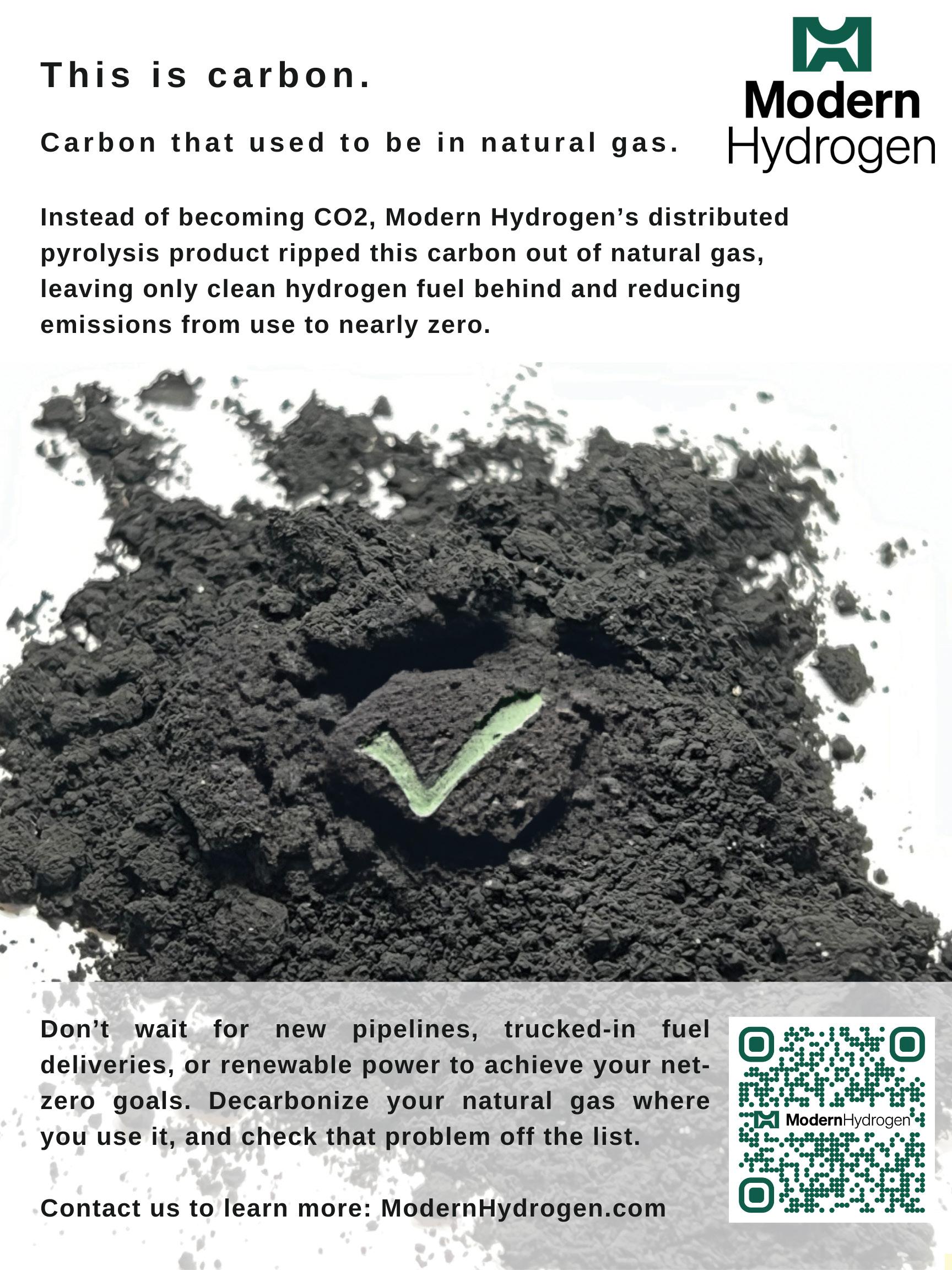
What’s brewing?
Ultra-high efficiency roaster brews up coffee producer’s sustainability solution.
By Monica Stavish Skaggs
In a U.S. region known for great java, Tony’s Coffee Roastery in Bellingham, Washington, strives to produce delicious coffee while giving back to communities and the environment. As part of its sustainability pledge, the coffee producer installed an ultra-high efficiency, large natural gas coffee roaster that helps save 80% on energy usage.
The company’s mission is to use energy-efficient solutions and reduce its carbon
footprint. By 2030, Tony’s Coffee pledges to become historically carbon neutral by offsetting its entire carbon emissions since 1971, the year it was formed.
Since its beginning, the coffee producer has roasted coffee in small batches, using quality beans from around the world. The company also works to offset its roastery’s carbon footprint by reinvesting in the local community and coffee farming communities.
In 2002, Tony’s Coffee was one of the nation’s first coffee roasters to source organic, fair trade, shade-grown coffee from farmer-owned cooperatives. Two years later, Tony’s Coffee joined the U.S. Roasters Guild and, in 2012, became a founding member of World Coffee Research, which focuses on sustainable coffee production.
Tony’s Coffee installed an ultra-efficient, American-built natural gas Loring S70 Peregrine™ roaster from Loring Smart Roast Inc. The single-burner roaster’s technology enables the company to reduce its carbon footprint at its roastery by more than 40%. Loring S70’s Flavor-Lock Roast Process™ technology offers smokeless, odorless exhaust during roasting, and a high-speed cooling tray reduces cooling time while protecting the beans.
er oxidation requirements, while still meeting local air quality and odor emission-stipulated levels, said Bradey Day, commercial/industrial energy efficiency program manager for Cascade Natural Gas Corp. (CNGC).
“That means a savings of approximately 12,600 therms in the first year,” he added. “The reduction of gas needed to perform the roasting process allows for less natural gas to be used, thus, reducing their carbon footprint.”
Tony’s Coffee’s investment of $229,000 in the project earned it an incentive of $42,840 from CNGC’s Commercial Incentive Program. It’s one way Cascade encourages its customers to use gas more efficiently to reduce waste, contributing to a more sustainable future.
Cascade serves more than 310,000 residential, commercial, industrial and transportation customers in 95 communities in western and central Washington and eastern Oregon.
Tony’s Coffee Roastery in Bellingham, Washington, uses a Loring S70 Loring S70 Peregrine Roaster with design features that reduce afterburner oxidation requirements, while still meeting local air quality and odor emissionstipulated levels. The ultra-high efficiency natural gas coffee roaster helps save 80% on energy usage.
The stainless-steel roaster has a capacity of 70 kilograms (about 154 pounds) of green coffee beans per batch and offers a fully automated roasting process. In addition, it provides up to 80% fuel-savings and reduction of greenhouse gases in every roast compared to conventional roasters.
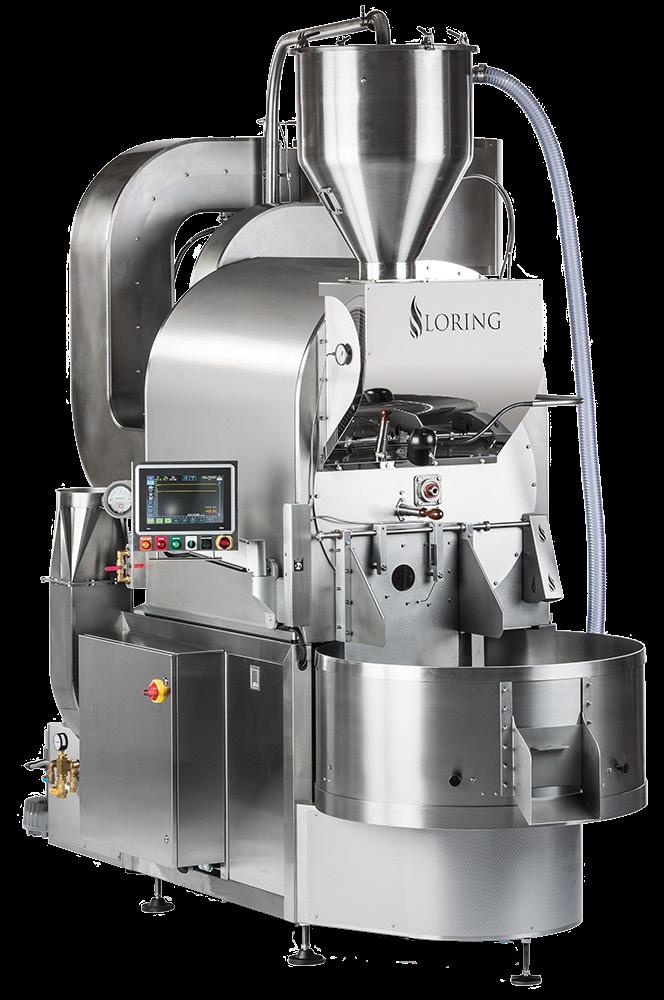
The existing roaster, which required up to 25 therms/hour of natural gas, was replaced with the new Loring S70 roaster that uses only six therms/hour because of design features that reduce afterburn-
“From our perspective, the incentive program offers the customer a truly winwin solution,” Day said. “While there is an upfront investment for the customer, the incentives help offset some of those costs. In addition, over time with the gas savings, the customer will realize even more savings and help cut down on their greenhouse gas emissions.
13
For more information, visit: Tony’s Coffee Roastery: tonyscoffee.com Loring Smart Roast Inc: loring.com
P H o T o C ou RTES y o F C ASCADE N AT u RAL G AS Co RP
Chilling with natural gas
Connecticut school district earns tax credits while saving energy and protecting the environment.
By Monica Stavish Skaggs
A Greenwich, Connecticut, high school is using combined heat and power (CHP), or cogeneration, as an energy source to keep students comfortable during the school year while cutting costs and protecting the environment.
Greenwich Public Schools is also enjoying increased and expanded tax credits under the Inflation Reduction Act of 2022, which applies to systems that incorporate certain low emission technologies. That includes mechanical CHP equipment installed by Tecogen Inc.
Greenwich High School is one of the state’s largest high schools and serves about 2,700 students. Greenwich is a suburban community with 63,000 residents located an hour from New York City.
In 2021, Tecogen installed a single 200-ton natural gas engine-driven chiller at Greenwich High School. In late 2022, Tecogen received an additional order for three 400-ton DTx chillers. The DTx chillers have been installed, and along with the previously installed STx chiller, provide 1,400 tons of cooling at the facility.
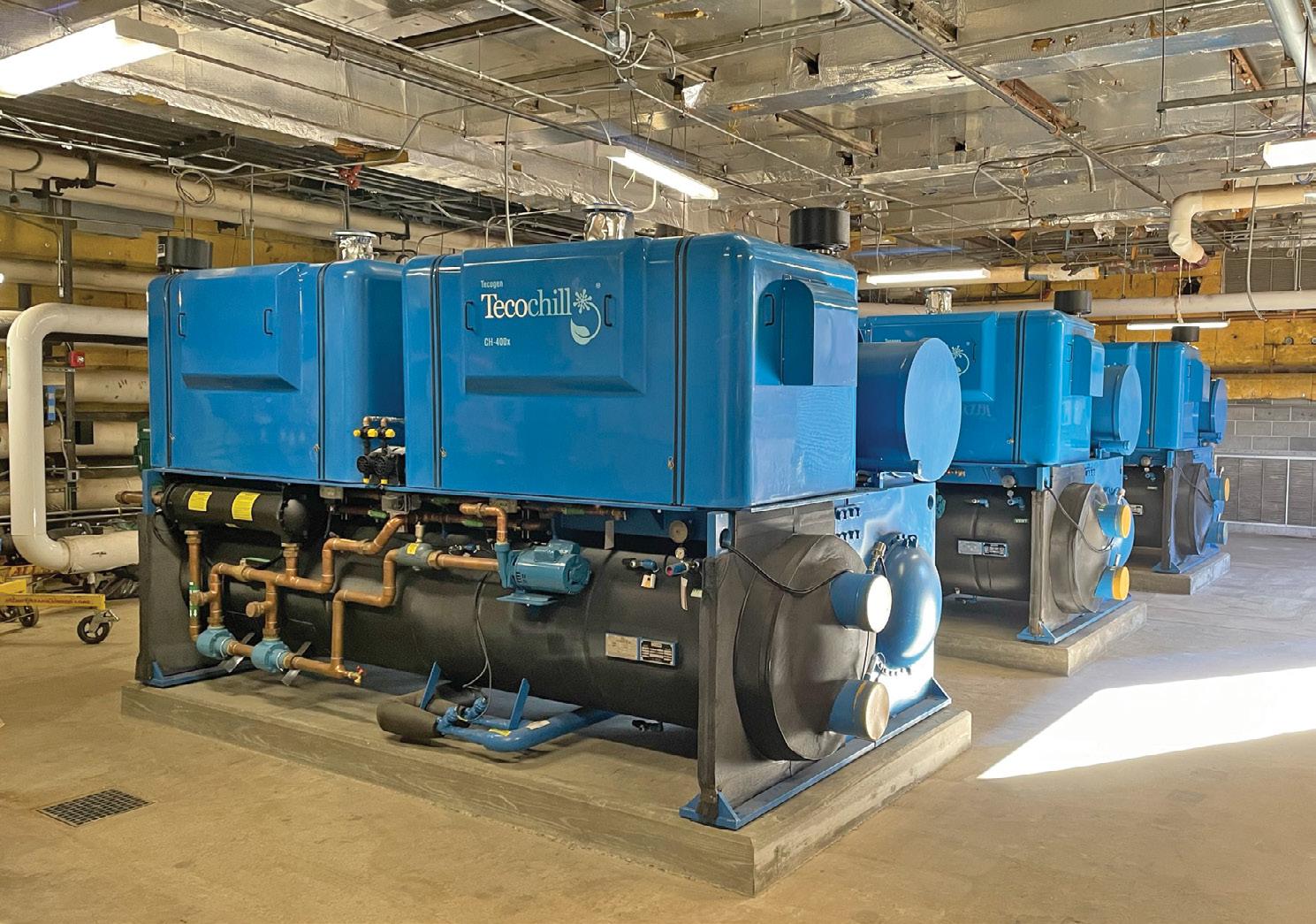
“Our three DTx and single STx chillers
replaced old, inoperable direct fired absorption chillers,” said Jeff Glick, vice president of sales at Tecogen. “All of the by-
product thermal output from cooling the engines and exhaust is being used for reheat dehumidification of the school.”
The new chillers will reduce carbon emission by more than 1,100 tons per year. The chilled water can be used to cool the large high school while at the same time, the byproduct hot water will be utilized to perform reheat dehumidification for the building. Powered by clean, economical natural gas, the DTx chillers reduce operating costs by 50% and cut carbon footprint by more than half.
“Using both the chilled water and hot
14 energysolutionscenter.org
P H o T o C ou RTES y T EC o GEN I NC .
Greenwich High School in Greenwich, Connecticut, uses Tecogen Inc. natural gas engine-driven chillers to provide 1,400 tons of cooling at the school.
Using both the chilled water and hot water simultaneously will allow the units to operate as a CHP system and, therefore, qualify for the new Federal Investment Tax Credit of 40%.
— Jeff Glick, vice president, sales, Tecogen Inc.
water simultaneously will allow the units to operate as a CHP system and, therefore, qualify for the new Federal Investment Tax Credit of 40%,” Glick said.
CHP is the simultaneous production of electrical or mechanical power and thermal energy from a single fuel source. It brings a tremendous benefit to facilities such as schools, which consistently need electricity, chilled water and hot water. The new chillers are expected to save the district tens of thousands of dollars per year. Saving money on energy costs frees up more funding to meet the educational needs of students.
The Inflation Reduction Act increased tax credits, including the investment tax credit (ITC), to up to 30% of a project’s costs for ventures incorporating certain low emission technologies that begin construction before Jan. 1, 2025. An additional credit of 10% will also be available to the school district since the Tecogen equipment meets the require-
ments related to domestic content.
Tecogen is a clean energy company that designs, manufactures, installs and maintains high efficiency and ultra-clean cogeneration products, including CHP systems, air conditioning systems, and high-efficiency water heaters for residential, commercial, recreational and industrial applications.

The company’s cost efficient, reliable and environmentally friendly products for energy production nearly eliminate criteria pollutants and significantly reduce customers’ carbon footprint. Tecogen has been in business for 35 years and its units are supported by a network of engineering, sales and service personnel throughout North America.
Tecogen supports expanded tax credits that provide incentives for purchases of its CHP equipment, said Tecogen CEO Abinand Rangesh. In addition to energy cost savings, other benefits include near-zero emissions and increased resil-
iency to grid power shortages, outages and demand charges.
“We are pleased that the tax provisions in the Inflation Reduction Act recognize the benefits available from CHP equipment and provide incentives for incorporating CHP equipment into HVAC [heating, ventilation and air conditioning] systems,” he said. “We look forward to working with customers who wish to take advantage of significantly improved economics associated with an investment in our cogeneration equipment and chillers.”
15
P H o T o C ou RTES y T EC o GEN I NC For more information, visit: Tecogen Inc.: tecogen.com The Inflation Reduction Act: bit.ly/3Q0Xavc
Powered by clean, economical natural gas, Tecogen chillers reduce operating costs by 50% and cut carbon footprint by more than half.
Boosting energy efficiency
Energy
By Tonya McMurray
Whether it’s running systems 24/7 or relying on automated set points that no longer optimize energy, many organizations have practices that result in inefficient energy use. Services and technology that provide in-depth analyses can help find those inefficiencies quickly, saving both energy and money.
baCk to sChool
With more than 10,000 students in 22 schools across Bloomington, Minnesota, Bloomington Public Schools uses a lot of energy. The district uses energy management and building automation systems to help control energy use but wanted to decrease its energy use even more. CenterPoint Energy Inc. worked with the district to identify ways to maximize its energy efficiency through the utility’s Natural Gas Energy Analysis.
Based on the comprehensive analysis of energy use in the district’s facilities, Frontier Energy Inc. — which helps companies use energy more efficiently — recommended several measures that could save on natural gas use, including water heaters, boilers, insulation and kitchen equipment, said Matt Haley, vice president for Frontier Energy.
“CenterPoint was able to educate the customer,” he said. “They showed the school where their energy costs were and helped them know where they needed to upgrade and optimize major systems.”
The district had more than 200 air handling units across the district, each with multiple zones and digital set
Schools are still struggling from post-COVID-19 labor challenges … Energy audits allow building staff to take a step back from their busy schedule and gauge the impact of projects they have recently completed as well as forecast their energy use without too much burden on their time.
points to control operation. The Natural Gas Energy Analysis found that Bloomington’s school buildings were over ventilated throughout the day and identified opportunities for improving nighttime setbacks.
“All of these changes were no-cost, and school staff made the changes to begin saving on their energy costs immediately,” Haley said. “This, along with other direct installation activities such as installing door sweeps and low flow water products, led to a natural gas savings of more than 4,000 [MMBtus].”
Haley said the changes made after the energy analysis helped Bloomington Public Schools identify opportunities to better allocate limited school resources.
“Schools are still struggling from post-COVID-19 labor challenges,” he said. “Services like the Natural Gas
Energy Analysis program offered by CenterPoint Energy are well received by facilities staff since they focus on last-mile delivery of low-cost and nocost energy savings while providing resources to schools for long-term planning and management of their energy goals through post-audit support and incentives. Energy audits allow building staff to take a step back from their busy schedule and gauge the impact of projects they have recently completed as well as forecast their energy use without too much burden on their time.”
aRtiFiCial iNtelligeNCe solutioNs
Energy technology company METRON Inc. offers software as a service (SaaS) that automates energy analysis, using artificial intelligence (AI) to better visualize and understand data
16 energysolutionscenter.org
analyses and software systems identify energy inefficiencies and highlight opportunities for saving.
— Matt Haley, vice president, Frontier Energy Inc.
while identifying ways to improve operational efficiencies.
In 2021, METRON collaborated with Southern California Gas Co. (SoCalGas) to demonstrate the software’s ability to improve energy efficiency. SoCalGas identified The Gill Corporation, one of its large customers, as an ideal host site.

The Gill Corporation — a manufacturer of high-performance composite materials and products for the aerospace, transportation and other industries — did not have a centralized energy management system or a way to monitor energy use across the company.
“They had a lot of operational data, and there was an opportunity to utilize that data for energy savings and operational enhancement,” said Alan Leung, customer end-use applications project manager for SoCalGas’ research, development and demonstration (RD&D) team. “The software
identifies patterns and provides actionable recommendations that could improve our customer’s bottom line.”
For example, the company had oxidizers coupled with its furnace that ran nearly nonstop so the oxidizer would always be ready. However, the software identified that the oxidizer typically only needed about 30 minutes to ramp up before a furnace cycle, allowing The Gill Corporation to shut off oxidizers throughout facility when they were not in use.
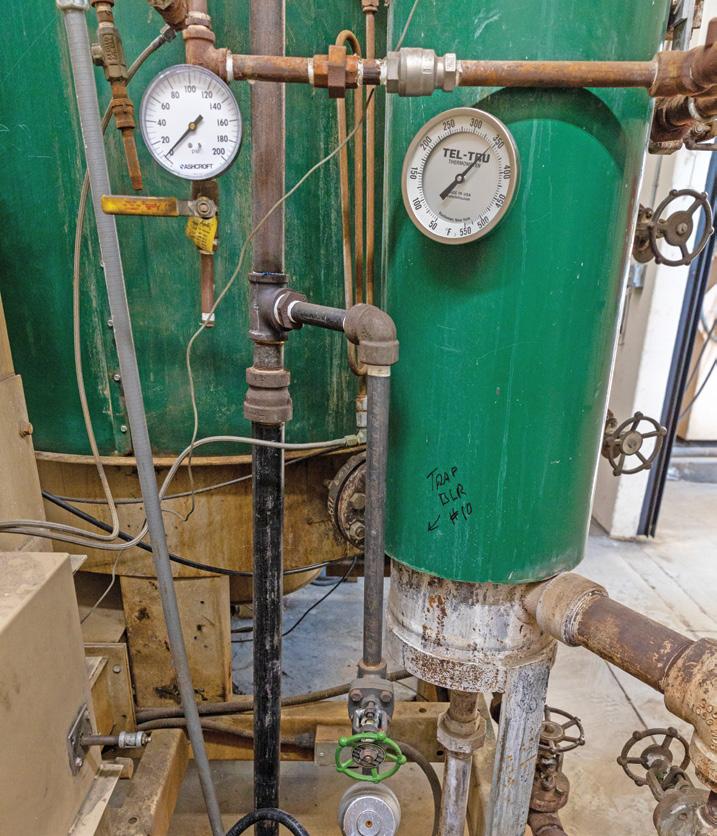
METRON’s software also identified ways to optimize boiler operation. Prior to the software analysis, The Gill Corporation had three major boilers providing steam for process heat.
“It was running inefficiently and offered another lever for energy savings and operational efficiency,” Leung said. “The team realized they could run one of the boilers at 70% to 80%, run a second boiler at 50% and only run a third during peak loads. That quickly brought the consumption of natural gas down and reduced the audio pollution from the boiler system.”
Leung said The Gill Corporation benefited from both energy savings and a better understanding of energy use. In addition, the software helped identify a leaking air compressor, allowing repairs to be made before the equipment failed.
The Gill Corporation was able to identify annual utility savings of $150,000 and reduce associated carbon dioxide emissions by nearly 1,000 metric tons per year.
For more information, visit:
17
Frontier Energy Inc.: frontierenergy.com METRON Inc.:
metsci.com
Southern California Gas Co. and The Gill Corporation team members review reports generated by METRoN’s software that uses artificial intelligence to automate energy analysis, helping companies to improve efficiency and better visualize and understand data.
P H o T o C ou RTES y o F Sou THERN C ALIF o RNIA G AS Co. P H o T o C ou RTES y o F SoC AL G AS
METRoN’s software helped The Gill Corporation optimize its boiler operation by identifying when and at what capacity the boilers needed to operate. The result was reduced audio pollution and lower natural gas consumption.









Helping Leaders Create Healthy Working Environments for Hard-Working People Learn more at www.cambridgeair.com/rng-ready • 800.899.1989 S-Series HTHV Heaters • M-Series Make-Up Air • ESC-Series Evaporative Cooling ■ ACHIEVE YOUR ESG GOALS – Reducing your carbon footprint is a crucial aspect of achieving your company's Environmental, Social, and Governance (ESG) goals. Cambridge Air Solutions direct-fired HTHV and make-up air technologies are known for delivering high energy e iciency compared to other units available in today's market. Our product performance helps to minimize energy waste and lower carbon emissions. ■ RNG READY PRODUCTS – Both our Cambridge Air Solutions S-Series direct-fired HTHV and our M-Series make-up air product lines are renewable natural gas (RNG) ready. LEARN MORE cambridgeair.com/rng-ready Cutting-Edge S-Series HTHV Heating and M-Series Make-up Air Technologies That Harness Renewable Natural Gas for Sustainable Greenhouse Gas Reduction RNG


 By Drew Robb
By Drew Robb



































